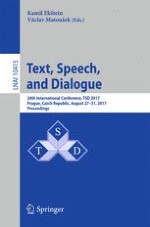This book constitutes the proceedings of the 20th International Conference on Text, Speech, and Dialogue, TSD 2017, held in Prague, CzechRepublic, in August 2017.
The 56 regular papers presented together with 3 abstracts of keynote talks were carefully reviewed and selected from 117 submissions. They focus on topics such as corpora and language resources; speech recognition; tagging, classification and parsing of text and speech; speech and spoken language generation; semantic processing of text and speech; integrating applications of text and speech processing; automatic dialogue systems; as well as multimodal techniques and modelling.
